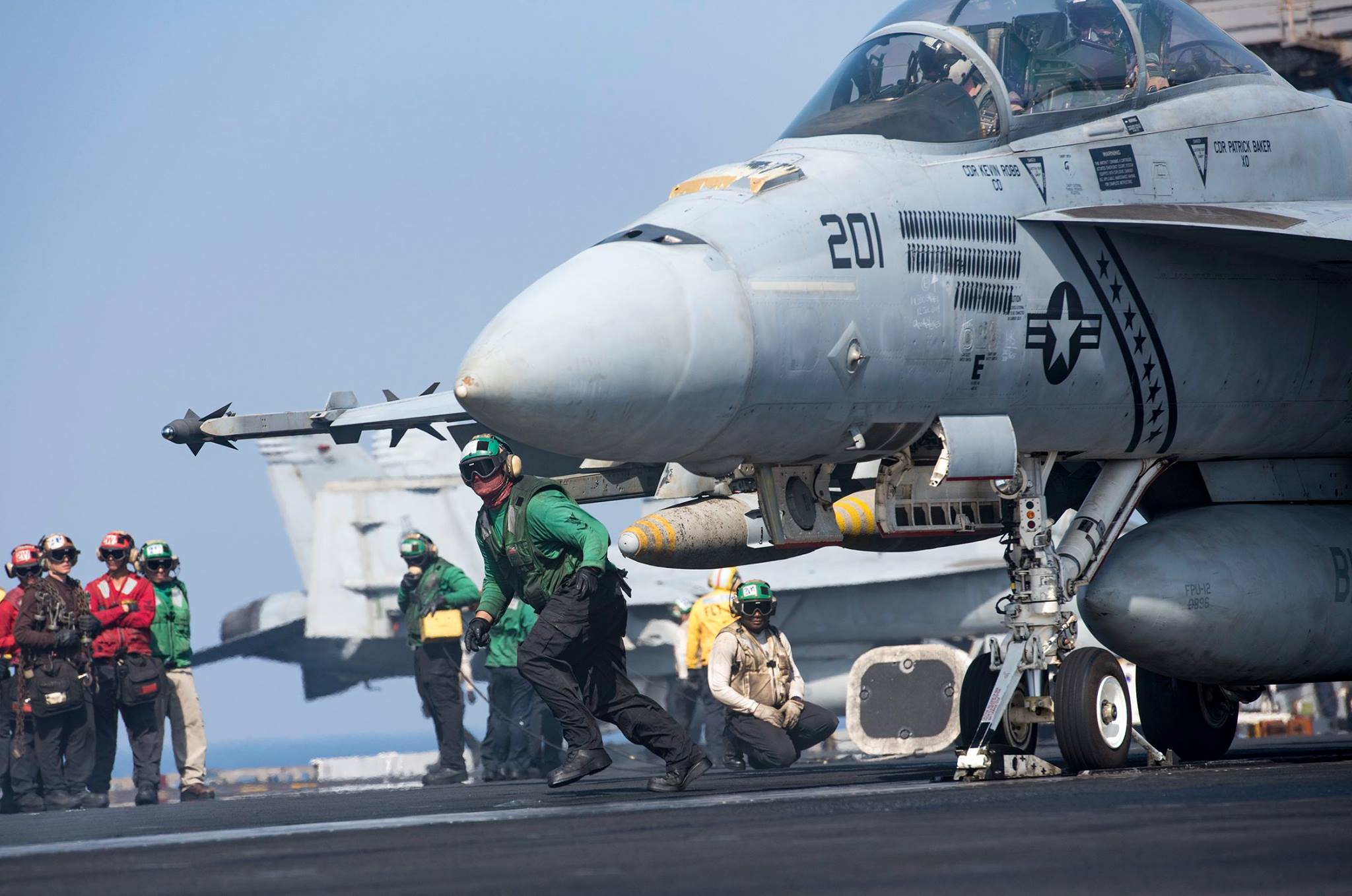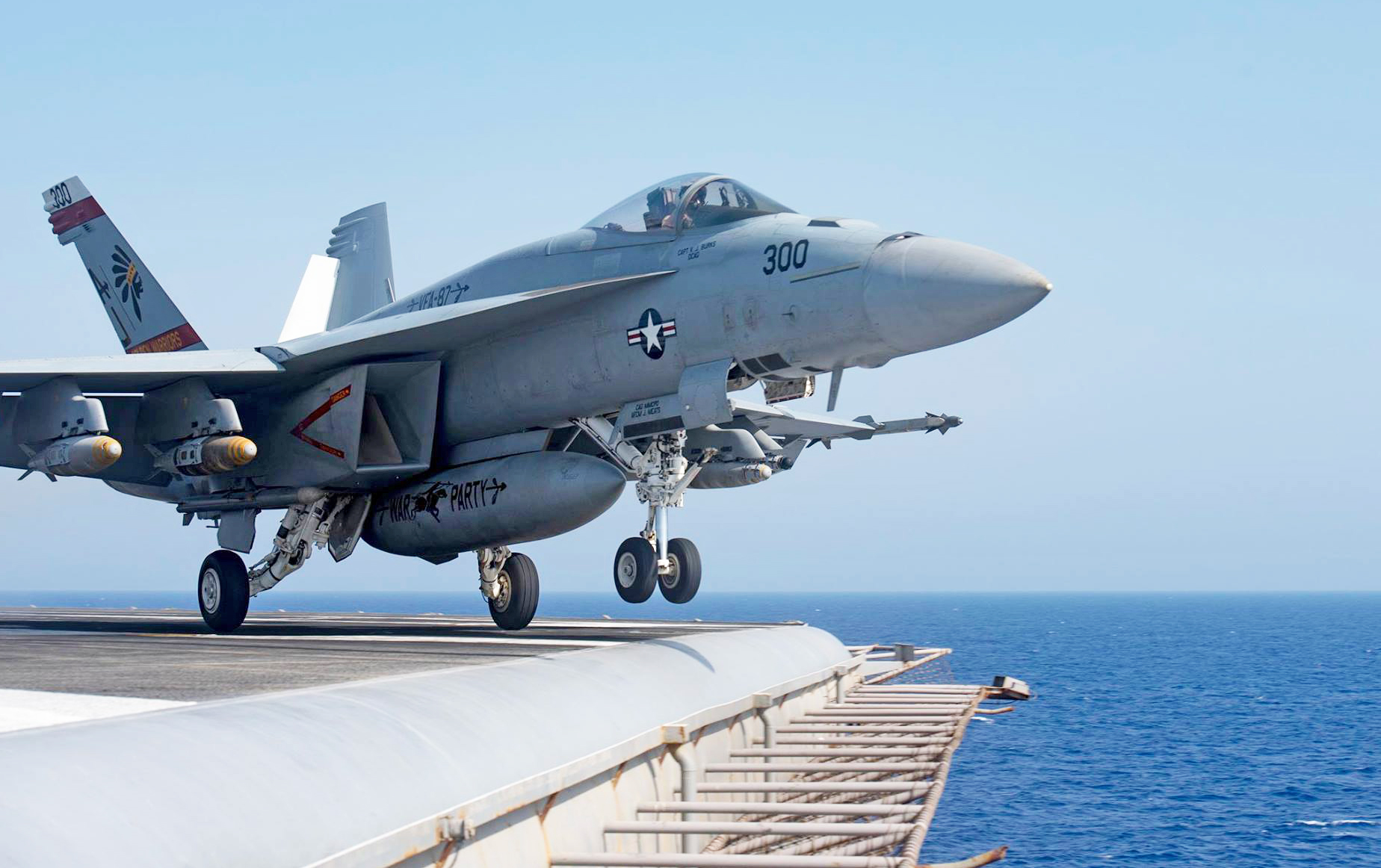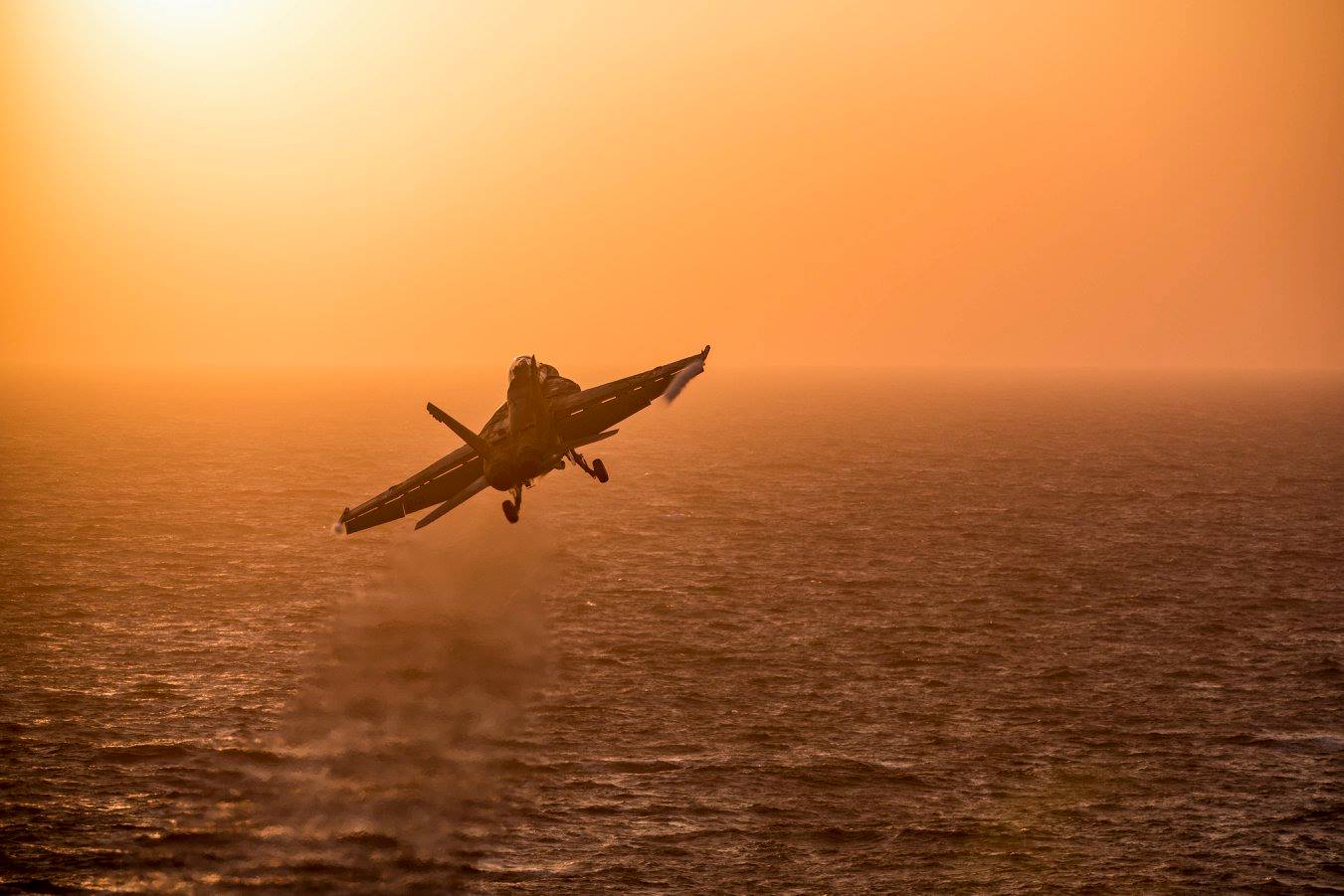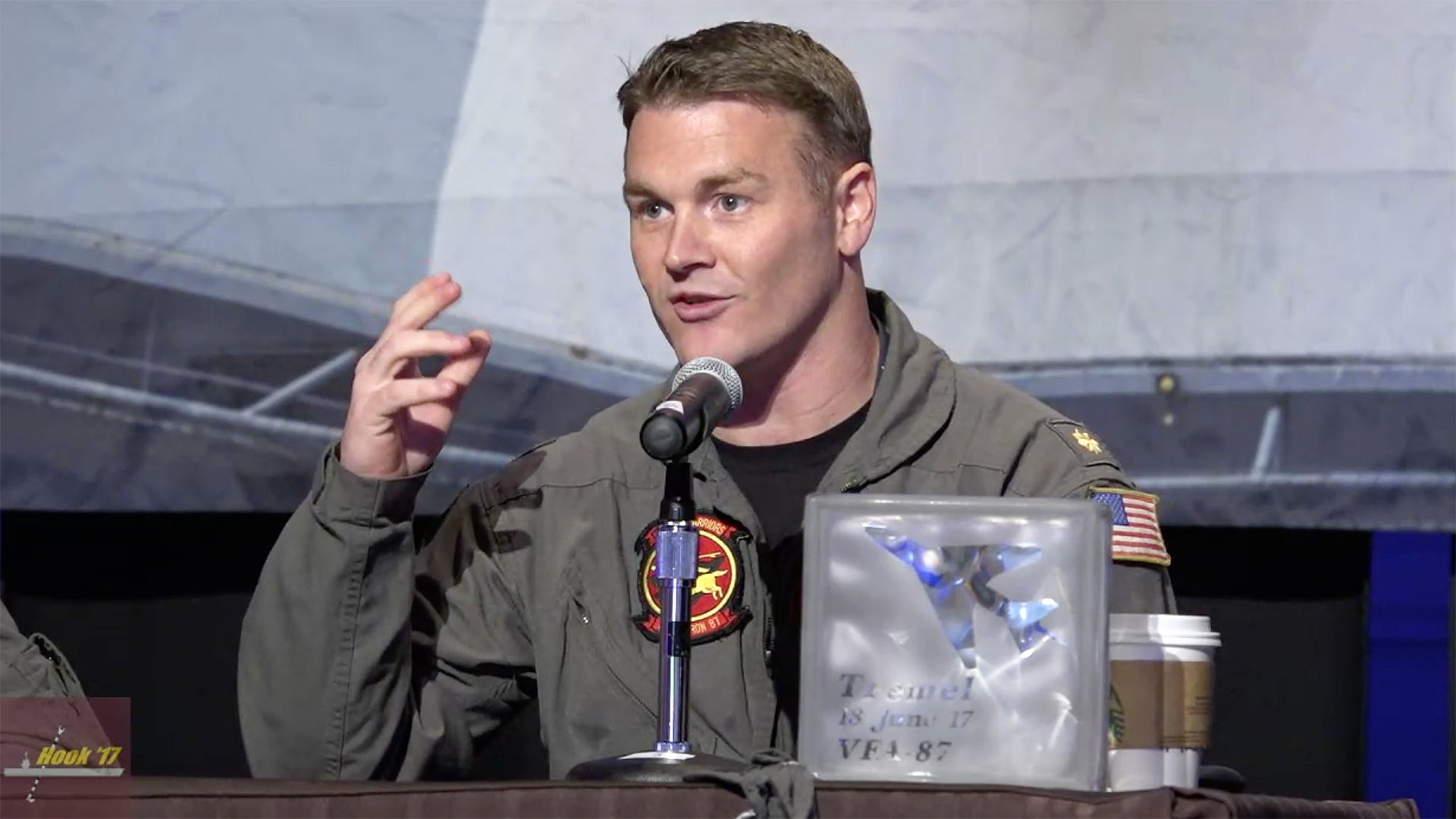The Tailhook Association’s annual symposium wrapped up on Sunday and the event featured a special panel this year—the quartet of Hornet and Super Hornet pilots who were involved in the mission that resulted in the shooting down of a Syrian Su-22 Fitter. Their detailed account of the historic mission provides by far the most concise and thorough picture of not just the engagement itself, but what came before it and after. It also offers some unique insights into the complex air war over Syria.
Below is a summary and some of the takeaways based on the combined accounts of not just Lt. Cmdr. Michael “Mob” Tremel who shot down the Syrian Fitter, but also of his wingman from VFA-87 “Golden Warriors” and two pilots who flew a section of F/A-18Cs belonging to VFA-37 “Bulls” who were in the air alongside them during the mission.
The full video of the presentation can be viewed here. There’s a lot of detail in it and at times it is pretty damn comical as well. I would highly recommend watching it.

The mission started out as just another close air support sortie over Syria. Freedom 33 and 34 were Tremel and his wingman flying F/A-18Es, Freedom 43 and 44 were another section of F/A-18Cs headed to the same area near Raqqa to provide on-call air support. The mission of the carrier’s air wing at the time was clear—to attack ISIS and to help protect friendly forces on the ground in both Syria and Iraq.
During the carrier’s time in the area of operations some big things had happened that underlined an increasingly complex situation in Syria, which could also affect the air war happening over the country. First was the Tomahawk missile attack on Shayrat airfield in early April. The second was the shooting down of an Iranian drone over southern Syria by a USAF F-15E in early June. As such, the rules of engagement were constantly changing and the carrier’s fighter crews were being told that they needed to be ready to defend ground units from a third party aerial attack, along with a slew of other air-to-air contingencies.
The crews briefed and launched off the carrier as part of the second wave of aircraft being sent into Syria from the aircraft carrier that day. The USS George H.W. Bush was operating in the eastern Mediterranean south of Crete at the time. There had been lots of air-to-ground weapons “drops” made earlier that day so there was a good likelihood that the four pilots could also see some action. The Bulls’ commander, who was part of the earlier wave of missions into Syria, was on the radio and the pilots could tell from his transmissions that the situation on the ground around ISIS’s de facto capital of al Raqqa was heating up.

They took the northern route into Syria which likely took them over Turkey and around Russian air defenses arrayed along Syria’s coastline. The flights checked in with the Joint Terminal Air Controller (JTAC) on the ground south of the city of al Tabqa, an area where Syrian forces were getting dangerously close to friendly forces.
The group of four strike fighters entered the close air support stack (CAS stack) overhead the JTAC and waited for any requests for strikes when a Russian Su-27 showed up and began loitering high overhead.
Mob, who was having issues with his targeting pod, was assigned to keep tabs on the circling Russian fighter while the other pilots continued with their CAS mission. He turned the Super Hornet’s master mode to air-to-air and began tracking the Su-27 and searching the skies around the area for other aircraft.
Then another radar track appeared—a fast moving aircraft coming from the south directly towards him. Although Mob figured it was probably a Syrian aircraft, he moved to intercept the target and eventually made a visual identification on what turned out to be a Syrian Air Force Su-22 Fitter swing-wing attack jet—the same type of aircraft used to deliver the gas attack that led to the Tomahawk missile strike a few months earlier.

Mob made it clear during the presentation that if the Syrian jet just turned away that would have been great as they had plenty to do in support of ground forces, but that didn’t end up being the case.
After identifying the Su-22, Mob got on the radio with an airborne command and control post, an E-3 Sentry, and had them broadcast warnings repeatedly over guard frequency to the Syrian jet. Those radio calls did not result in a change of course by the Syrian pilot. Then Mob “thumped” the Su-22 three times—flying close over the jet’s canopy and popping flares out in front of it before breaking off—to warn him away. That didn’t work either.
By then the Su-22 was in striking distance of friendly forces and it began to dive, releasing its weapons in the process, before making a climb out after the attack. Based on the rules of engagement that were briefed to the naval aviators, Mob locked the Su-22 up from behind with an AIM-9X Sidewinder and fired.
The missile zipped off the Hornet’s wing rail trailing smoke but quickly disappeared. It wasn’t clear why the missile failed to track the Su-22 or where it had gone. Mob quickly selected an AIM-120 AMRAAM and fired once again. He noted how long it took for the missile to fire off the Super Hornet’s “cheek” station located along the outer edges of its air intakes.
Regardless, the missile tracked the Fitter flying just a short distance away and exploded on its backside, pitching it violently to the right and downward. The pilot was clearly seen ejecting from the doomed swing-wing attack jet.
The ejection seat passed very close down the right sight of Mob’s canopy. He noted how live-fire training helped him during the engagement because he knew what to expect and quickly rolled away from the explosion instead of flying through it.
The Syrian pilot’s chute blossomed, it was white, green, and orange in color and his emergency transmitter beacon began going off over the radio.
By now Mob and his wingmen found themselves low down and deep inside an enemy air defenses engagement zone. With the entire power structure over Syria potentially shattered, and the Russian Flanker still orbiting overhead, Mob jettisoned his air-to-ground ordnance. With things having become somewhat quiet on the ground and considering one of the friendly jets above just shot down a hostile fighter, the JTAC released the division of jets and they began to cautiously egress out of the area.
Luckily a KC-10 Extender tanker was made available to them and everyone had a moment to relax and collect their thoughts during the aerial refueling evolution. The panel of pilots all pretty much noted just how nice it was to have the KC-10’s big soft refueling “basket” to plug into after such a stressful situation—a much more acceptable reality than having to refuel from a KC-135R’s “Iron Maiden” hose and drogue that attached to the tanker’s flying boom.

With just a single AIM-9X left on Mob’s jet, and having just shot down another plane, he and his wingman got cleared to return to the carrier. The other section of jets from VFA-37 was tasked to head to Mosul, Iraq to provide close air support for the then ongoing operation to route ISIS from the sprawling city.
The two F/A-18Cs quickly ventured east to Iraq, where they would have to follow a totally different set of rules of engagement. In the end one of the aircraft ended up dropping weapons on ISIS positions in the city before finally return back to the USS George H.W. Bush.
After executing a high-speed overhead break and landing aboard the ship, Mob taxied to a parking spot and got out of the jet. The scene was not like the triumphant ending moments of Top Gun, the Lieutenant Commander shook a few hands and was promptly told by the plane captain that he had to move along because the jet needed to rearmed and refueled as it was slated to head back into Syrian in hour.
Even down below in the ship’s squadron spaces Mob had to go about his normal business even though he had been the first Naval Aviator to down another jet in many, many years. As the Air Wing’s Safety Duty Officer he had to make his rounds collecting safety reports from various units—not glamorous work after racking up an enemy kill.
“The show goes on” as Tremel noted with a smile.
There were a few after-action takeaways from the mission as well. First off, the pilots referenced the HUD tape and cockpit recordings from this engagement. We had reached out to multiple commands shortly after the incident to obtain it but we were told it was classified/not releasable. Hopefully that will change because it is probably pretty spectacular considering the close ranges involved with the engagement and the multiple flybys on the doomed Syrian Fitter.
Additionally, everyone stressed how interactions with Russian aircrews happened all the time over Syria and were professional in nature. Even the Flanker that had been orbiting high above the Hornets when all this occurred followed them from a distance for a bit as they headed towards the tanker before turning back.
It sounds as if the air war over Syria and Iraq has settled into such a long term operation that the presence of an airborne early warning and control (AEW&C) aircraft in the region might not always be assured, nor are they really effective at directing counter-air activities for most tactical aircraft as they aren’t there for that mission. Instead they are concentrated on close air support activities. Mob and his flight was first alerted to the presence of the Su-22 via Mob’s own radar, not by an E-2 or E-3 early warning and control aircraft.
It’s not clear if this was a technical issue or an operational one, but a mixture of both may be most accurate. Really it seems like the AEW&C assets are based more on administering the air war than on being part of it on a tactical level. For F-22s or other dedicated counter-air assets they are probably heavily involved, but as the set of four Navy fighter pilots mentioned, there were no dedicated counter-air assets around that day.

One of the pilots also noted how training with captive training rounds, including different bombs and missiles, is important. Pilots and weapons systems officers interface with these weapons differently when they are actually hanging on the jet than when they are represented in the simulator or by the aircraft’s training software. He noted there are more options when it comes to how crews can employ them in real training than in virtual training.
The crews also noted that air-to-air missiles have been loaded and unloaded onto and off of Navy fighters for decades without a single operational use. The enlisted guys on the ship bear this burden even when it is extremely unlikely they will be used in actual combat. Yet when these weapons were finally needed, they were there and even with the dud AIM-9X, they ended up getting the job done. So hats off to the enlisted guys and gals that do the heavy lifting on the ship and on shore, without it crews wouldn’t be prepared for these types of contingencies.
The incident also highlights the Super Hornets multi-role capability, going from a bomb-laden close air support platform to an air-to-air fighter at the flick of a switch. It also underlines how good the pilots that fly them are. The Bulls F/A-18C pilots who didn’t get the kill but happily went on to drop bombs on ISIS in an entirely different country on the same mission is a testament to their ability to compartmentalize and adapt on the fly.

The crystal clear rules of engagement given to these crews before their mission, and higher-ups’ willingness to stand behind their crews when executing those rules of engagement on the fly was also a huge factor in the success of the engagement. The pilots know their decisions can have wide-ranging strategic impacts, but if they follow their orders precisely, and if they know that their commanders will support their actions made under those orders, the whole system works in a smooth and robust nature even in highly complex scenarios.
In some ways fighter pilots flying in a complex air warfare environment, especially one without heavy command and control support, have to be a judge, jury, and executioner of sorts, and their verdicts have to be doled out in a blink of an eye. Thus clear rules of engagement and well trained crews that can interpret and apply those rules appropriately are critical to success.
What’s also worth discussing is the conjecture surrounding the AIM-9X’s failure in this engagement. By the panel’s account it sounded as if the AIM-9X just went stupid/malfunctioned on its own. There was no talk of the Su-22 launching flares, and even if it had, the fact that many military pundits are definitively claiming that the unique infrared signature of Russian-built low-end decoy flares threw the AIM-9X off course is just silly. Missiles fail, especially air-to-air ones. They are complex devices that get battered around under high gravitational forces and slammed down onto carrier decks and runways throughout their lifetime. And yes, it’s possible that under certain parameters weaknesses could exist when it comes to the AIM-9X’s ability to track certain targets that use certain decoys under certain conditions. Then again maybe they don’t. Regardless, that doesn’t mean that is what happened in this instance or that the AIM-9X is somehow a lousy missile because of it.
The amount of research and development that has gone into the Sidewinder family of air-to-air missiles is unrivaled. And testing goes far beyond live fire shoots or lab-like settings. Entire soundstage like testing facilities are built for refining American air-to-air missile seekers’ abilities to prosecute a successful kill. Additionally, they are tested against all types of decoys, including non-traditional expendables like BOL IR decoys as well as various types of flares. So while anything is possible, there is no evidence that supports this theory that old Russian “dirty flares” defeat the AIM-9X’s highly sensitive imaging infrared seeker and programming logic.
Now the real question is what happened to that errant AIM-9X that was fired, or at least what was left of it? Russian would probably love to take a good look at it.
Maybe the biggest takeaway of all from this presentation is just how awesome our Naval Aviators are. These guys seem extremely talented and are affable and self deprecating all at the same time. It’s exciting to see that the Navy continues to attract top talent to its tactical air power ranks. And although Lt. Cmdr. Michael “Mob” Tremel pulled the trigger and was attributed the kill, it really was a team effort.

Contact the author: Tyler@thedrive.com
